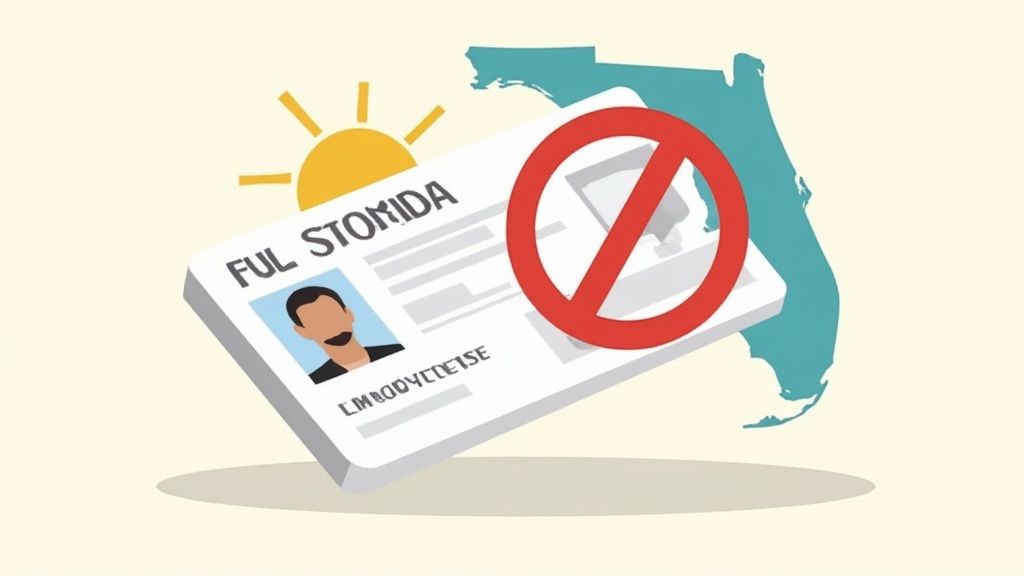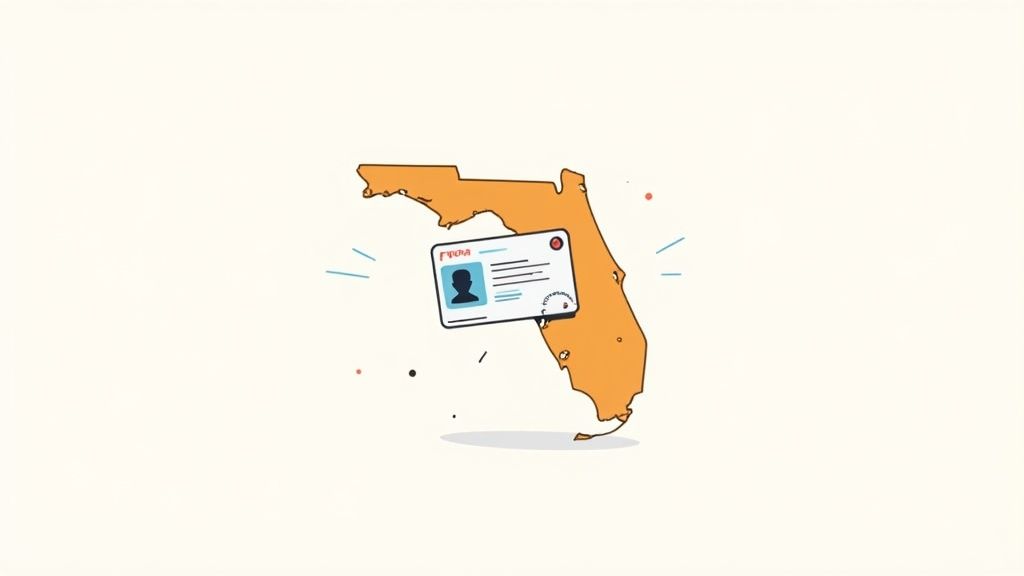Rain can turn a routine drive into a challenging experience. At DriverEducators.com, we understand the importance of being prepared for wet weather conditions.
In this post, we’ll share expert tips for safe driving in the rain, helping you navigate slippery roads with confidence. From vehicle preparation to handling common hazards, these strategies will keep you and your passengers safe during rainy journeys.
How to Prepare Your Vehicle for Wet Weather
At DriverEducators.com, we emphasize vehicle preparation before driving, especially in rainy conditions. Proper maintenance reduces your risk of accidents and breakdowns during wet weather.
Windshield Wiper Maintenance
Your windshield wipers serve as your first line of defense against rain. Replace them every six months, though extreme conditions could necessitate a shorter time before wipers need to be replaced. To test your wipers, spray your windshield with washer fluid. If the wipers don’t clear it in one swipe, it’s time for new blades.
Tire Safety
Tires maintain traction on wet roads. Check your tire pressure monthly using a reliable gauge. The National Highway Traffic Safety Administration has studied the effect of tire inflation on tire’s crash role during the pre-crash phase.
For tread depth, use the penny test. Insert a penny into the tread with Lincoln’s head upside down. If you can see all of Lincoln’s head, your tread depth is less than 2/32 inch and you need new tires.
Lights and Brakes Check
Functioning lights ensure visibility in rain. Walk around your vehicle to check if all lights work properly. Replace any burnt-out bulbs immediately.
For brakes, listen for unusual noises and pay attention to how your vehicle responds when you apply them. If you notice any issues, have a professional mechanic inspect your brake system.
Regular Maintenance Schedule
Try to establish a regular maintenance schedule for your vehicle. This includes oil changes, fluid checks, and general inspections. A well-maintained vehicle performs better in all weather conditions, including rain.
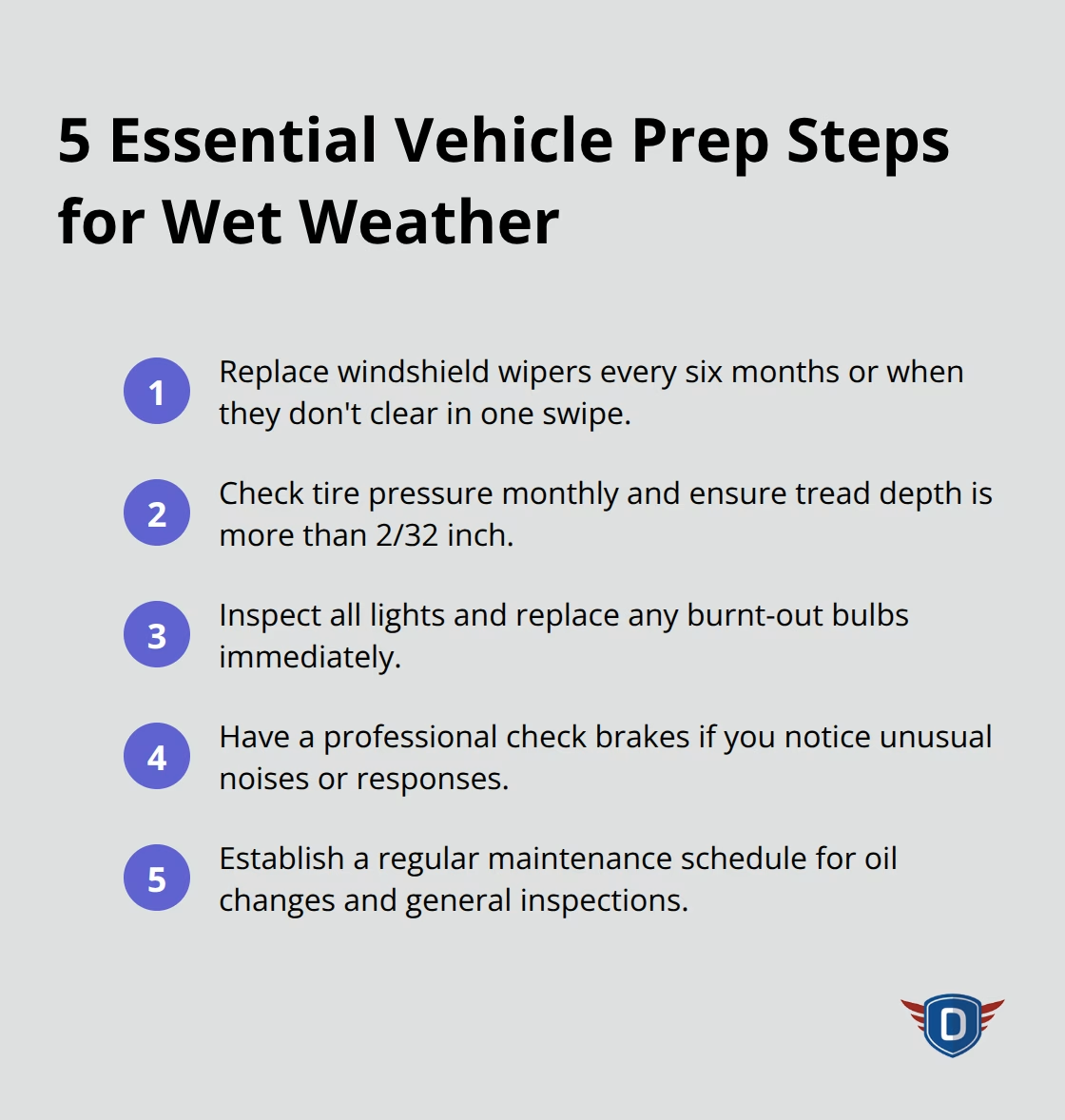
Emergency Kit Preparation
Prepare an emergency kit for your vehicle. Include items such as a flashlight, batteries, first-aid kit, and a basic tool set. In rainy conditions, you might also want to add a rain poncho and extra windshield washer fluid (these items can be lifesavers in unexpected situations).
Now that you’ve prepared your vehicle for wet weather, let’s move on to adjusting your driving techniques for rainy conditions. These skills will complement your well-maintained vehicle, further enhancing your safety on wet roads.
How to Adapt Your Driving in Rainy Conditions
At DriverEducators.com, we understand that rain transforms the driving experience. Wet roads require heightened awareness and modified techniques to ensure safety. Here’s how you can adapt your driving to rainy conditions:
Reduce Speed and Increase Following Distance
The primary rule for driving in rain is to slow down. The National Highway Traffic Safety Administration reports that speeding contributes to 30% of all fatal crashes during rainfall.
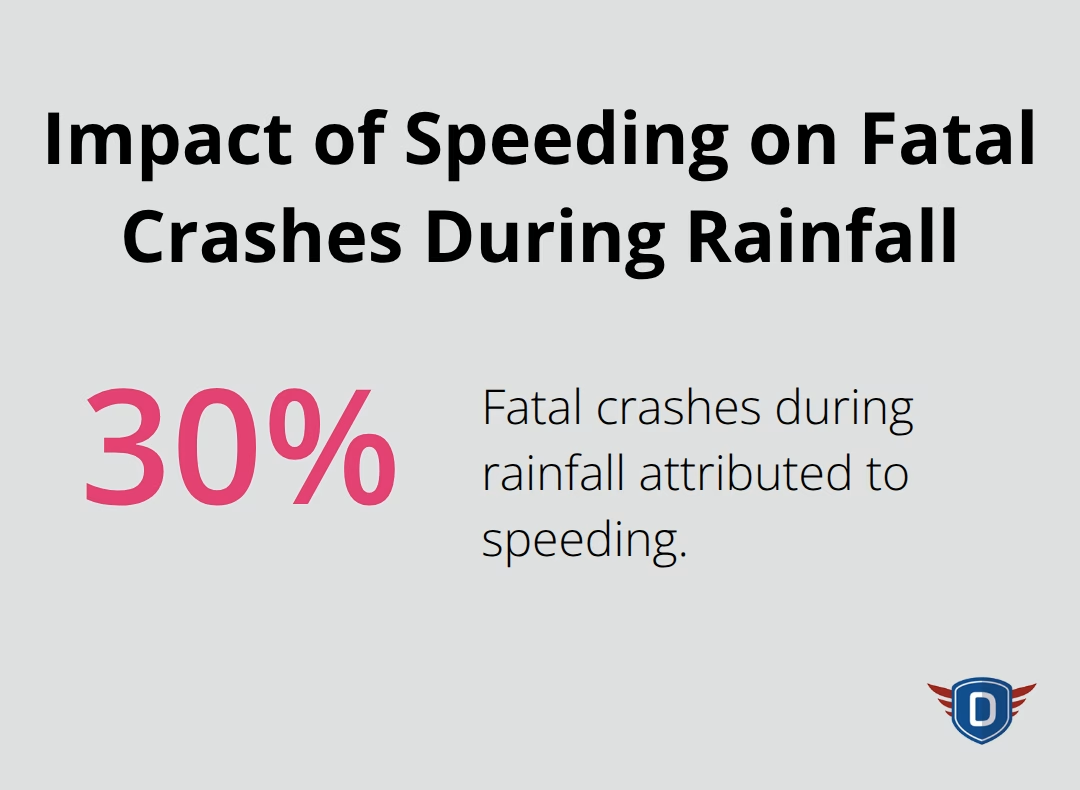
On freeways, light rain or snow can reduce average speed by 3 to 13 percent. Heavy rain can decrease average speed by 3 to 16 percent.
Increasing your following distance is equally important. Extend the standard 3-second rule to at least 5 seconds in wet conditions. This extra space provides more time to react if the vehicle ahead suddenly brakes or loses control.
Apply Smooth Driving Techniques
Smooth driving maintains control on wet roads. Avoid abrupt acceleration, braking, or steering. When you need to slow down, gently pump your brakes instead of slamming them. For vehicles with anti-lock brakes, apply steady pressure.
For turns, decrease your speed before entering the curve, not while you’re in it. This technique helps maintain traction and prevents skidding. A slight turn of the steering wheel can cause your car to react differently on wet roads compared to dry conditions.
Use Lights Properly for Maximum Visibility
Switch on your headlights whenever it rains, even during daylight hours. This improves your visibility and helps other drivers see you. Many states require headlight use when windshield wipers are on (a fact often overlooked by drivers).
Don’t use high beams in the rain. The bright light reflects off raindrops and can actually reduce visibility. Stick with your regular headlights. If your vehicle has fog lights, these can help in heavy rain as they illuminate the road close to your car without causing glare for oncoming traffic.
Handle Hydroplaning Situations
Hydroplaning happens when your tires are no longer in contact with the road surface in wet weather. Vehicles go into a skid due to wet conditions. If you experience hydroplaning, stay calm and follow these steps:
- Ease off the accelerator
- Hold the steering wheel straight
- Don’t slam on the brakes
- Gently steer in the direction you want to go once you regain traction
Try to avoid sudden movements that could cause you to lose control of your vehicle.
Now that we’ve covered how to adapt your driving techniques for rainy conditions, let’s explore some common hazards you might encounter on wet roads and how to navigate them safely.
Navigating Rainy Road Hazards
At DriverEducators.com, we understand that rain creates unique challenges for drivers. Even those with years of experience can encounter difficult situations on wet roads. Let’s explore some common hazards and how to handle them safely.
Hydroplaning Prevention and Recovery
Hydroplaning happens when tires lose contact with the road due to water buildup. The occurrence of hydroplaning can generally be minimized by various risk factors, such as having deeper and more intricate tire treads, higher inflation pressure, and reduced vehicle speed. To prevent hydroplaning, drivers should reduce their speed and avoid sudden movements.
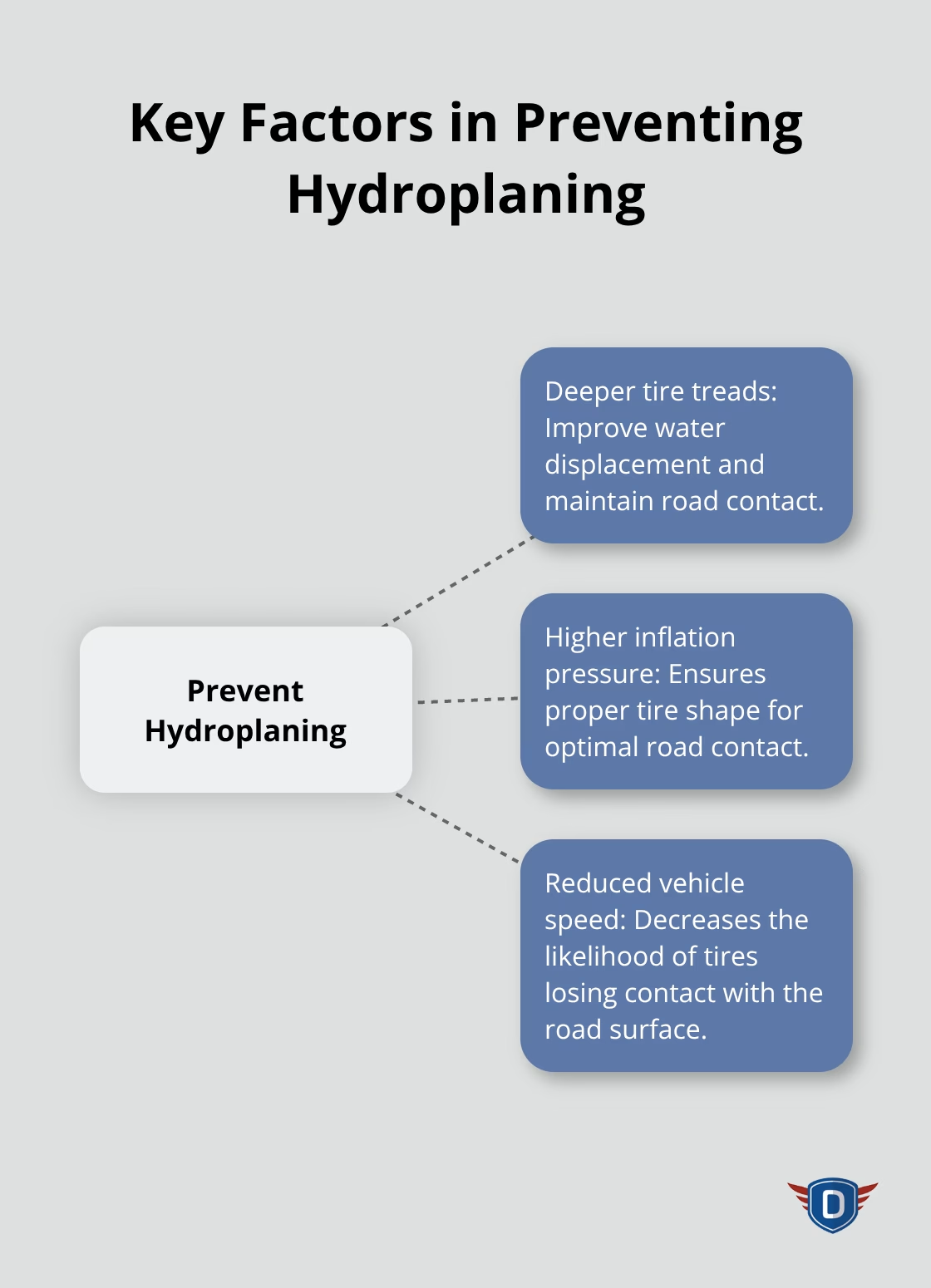
If hydroplaning occurs, drivers must not panic. They should ease off the accelerator and keep the steering wheel straight. Slamming on the brakes can cause a skid and should be avoided. Once the tires regain traction, drivers can gently steer in their intended direction.
Standing Water Dangers
Standing water on roads poses a significant threat. It takes just 12 inches of rushing water to carry away most cars and just 2 feet of rushing water can carry away SUVs and trucks. It is NEVER safe to drive or walk through flood waters.
When possible, avoid driving through standing water. If proceeding is necessary, drivers should move slowly and steadily to prevent creating a bow wave that could flood the engine. After passing through deep water, light brake taps help dry them out.
Slippery Road Markings
Wet painted road markings become extremely slippery. This decreased traction is particularly noticeable during acceleration, braking, or turning.
For safety, drivers should avoid sudden movements when crossing road markings in the rain. Extra caution is needed near crosswalks, stop lines, and lane dividers. Reducing speed and maintaining a steady course minimizes the risk of losing control.
Visibility Challenges
Rain significantly reduces visibility. Drivers should use their headlights to improve their ability to see and be seen by others. However, high beams should be avoided as they can reflect off raindrops and further reduce visibility.
Fog can often accompany rain, creating additional visibility issues. In these conditions, drivers should use low beam headlights or fog lights if available. They should also increase their following distance to allow for longer reaction times.
Brake Performance in Wet Conditions
Wet roads can significantly impact brake performance. Drivers should test their brakes after driving through deep water by applying light pressure to ensure they’re functioning properly. If brakes feel spongy or unresponsive, pumping them gently can help remove water from the brake components.
Final Thoughts
Rain transforms driving conditions, demanding heightened awareness and modified techniques. Drivers must reduce speed, increase following distance, and apply smooth driving techniques to maintain control on wet roads. Proper vehicle maintenance, including regular checks of windshield wipers, tires, lights, and brakes, plays a vital role in safe wet-weather driving.
We at DriverEducators.com strive to equip drivers with the knowledge and skills needed to handle various driving scenarios, including wet weather. Our comprehensive driver education programs cover essential tips for safe driving in the rain and other challenging conditions. Continuous learning and practice are essential to become a confident, safe driver in all weather conditions.
Safety on the road starts with you. Staying alert, adapting to conditions, and consistently applying safe driving techniques protect you and contribute to safer roads for everyone. Whether you’re a new driver or have years of experience, there’s always room to improve your skills (especially when it comes to wet-weather driving).
